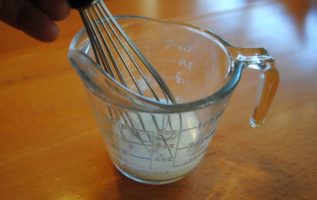
Learning to cook is kind of like learning to read in that, once you have the foundations down, you can create just about anything.
If you’ll go with this analogy, you can think of roux as a single word. In communications, a word by itself may not do much, but combined with others, it can help make a literary masterpiece.
Roux (say, “roo”) by itself isn’t much, but it lays a foundation for much greater things. Roux is just flour and fat cooked together. The flour is usually white wheat flour such as the all-purpose kind you use for making pancakes and other staples, and the fat can be just about anything: butter, vegetable oil, bacon grease or drippings from other meat.
Roux is not meant to be eaten by itself. Rather, it is used to thicken recipes such as soups, stews and gravies. In culinary school, roux is among the first things you make, and from there you learn to use it in dishes that may require some time to make, but are among some of the most flavorful on the planet, among them the kind of mac ‘n cheese you see above.
At this point you may be asking, “If I want to thicken a soup, say, why can’t I just throw in some flour and mix?” The quick answer is that you’ll likely end up with lumps and subpar flavor. The more technical answer is that when flour is cooked in fat, the process inactivates an enzyme that, if not nuked by the heat, will interfere with the flour’s ability to thicken.
There are three basic types of roux: white, blond and brown. They get their names from their color and how long you cook the flour. When the roux just barely takes on color, say cooking it just a minute or two, it’s white; cook it more and it’s blond, and further you get brown. The more you cook the roux, the deeper its flavor becomes.
Different rouxs are used for different uses. If you’re making a white sauce, you’ll want a white or blond roux, whereas a brown roux will give your dish a darker color and a deeper flavor. What is that flavor? Kind of nutty. It smells quite good when you’re making it, which is exactly what I’m going to show you how to do.
Of course, like I said, roux by itself won’t do you much good. So in coming columns I’m going to show you how to turn your roux into a béchamel sauce, a classic white sauce that is itself a foundation for others. From there, we’ll turn our lovely béchamel into a dynamite cheddar cheese sauce. From there, the sky is the limit, and you can use that cheese sauce for everything from mac and cheese to nachos to the one thing that will get kids to eat their veggies.
You can make these sauces in one fell swoop, or make the roux and store it for later. Once the roux has been cooked, you can spoon it into a small container – even an ice cube tray will work – and freeze it. When ready to use, pop your roux-icle into a pot, heat it up and then use as usual.
For now, here’s how to make roux.
BASIC BLOND ROUX
3 tablespoons of vegetable oil or butter, with more reserved if needed
5 tablespoons of all-purpose flour, with more reserved if needed
Step 1: Grab a heavy, thick pot and heat the oil on medium for a minute or so until hot.
Step 2: Add the flour and mix with a wooden spoon or whisk or medium-low to low heat.
Step 3. Continuously stir or whisk the roux until it turns a light brown color and smells nutty. This should take just a few minutes. The texture, as the culinary textbooks like to say, should look like “wet sand.” If yours looks like something else, adjust by adding more flour or fat accordingly. The longer you cook it, the deeper the color.
There. You just made roux. From here you could whisk in chicken or beef stock to make killer gravy or make a number of other recipes calling for a thick, velvety sauce. Stay tuned and I’ll show you how to make béchamel sauce in the next I Want to Cook.
Source: iwanttocook.com (defunct blog)































